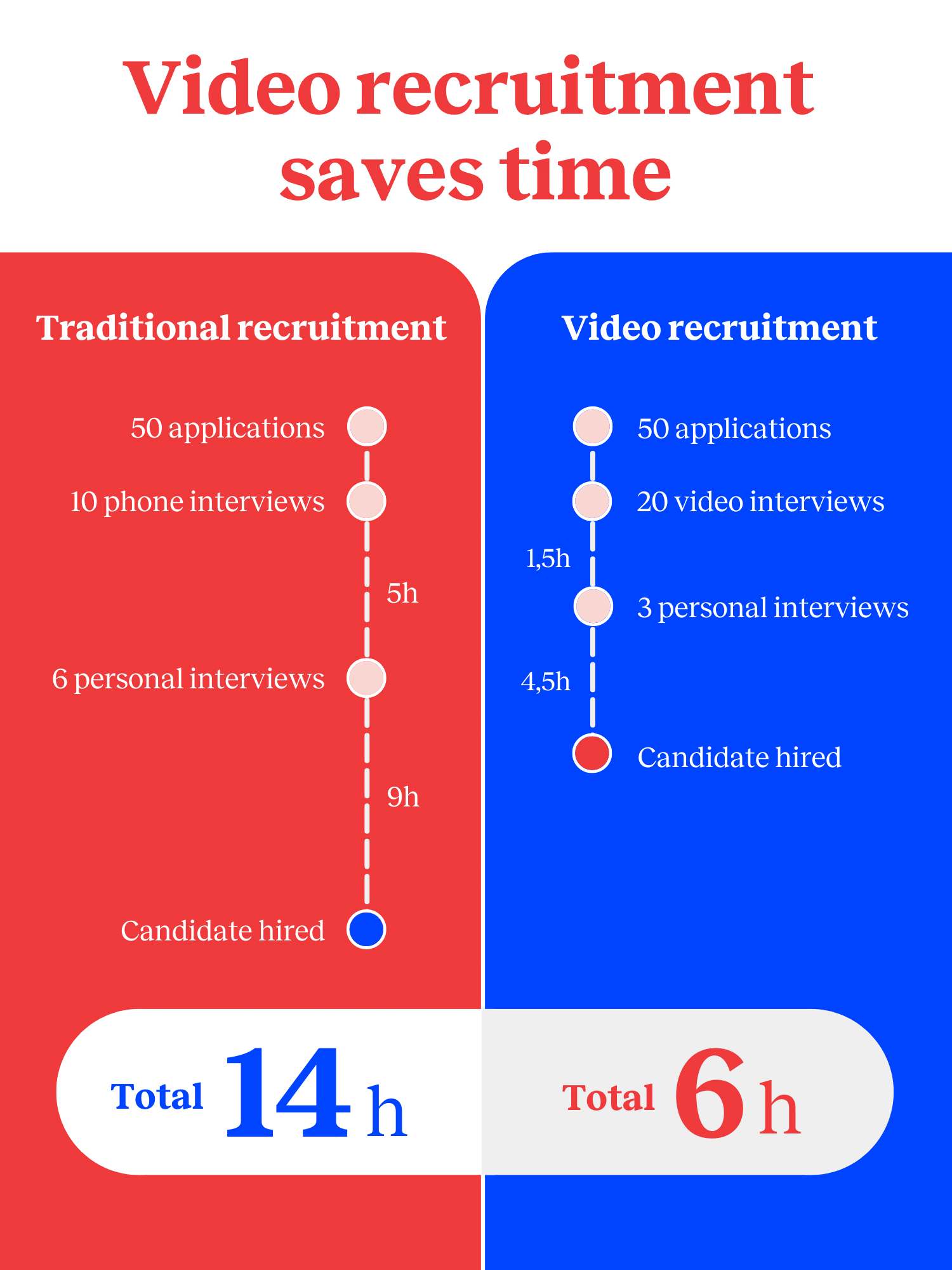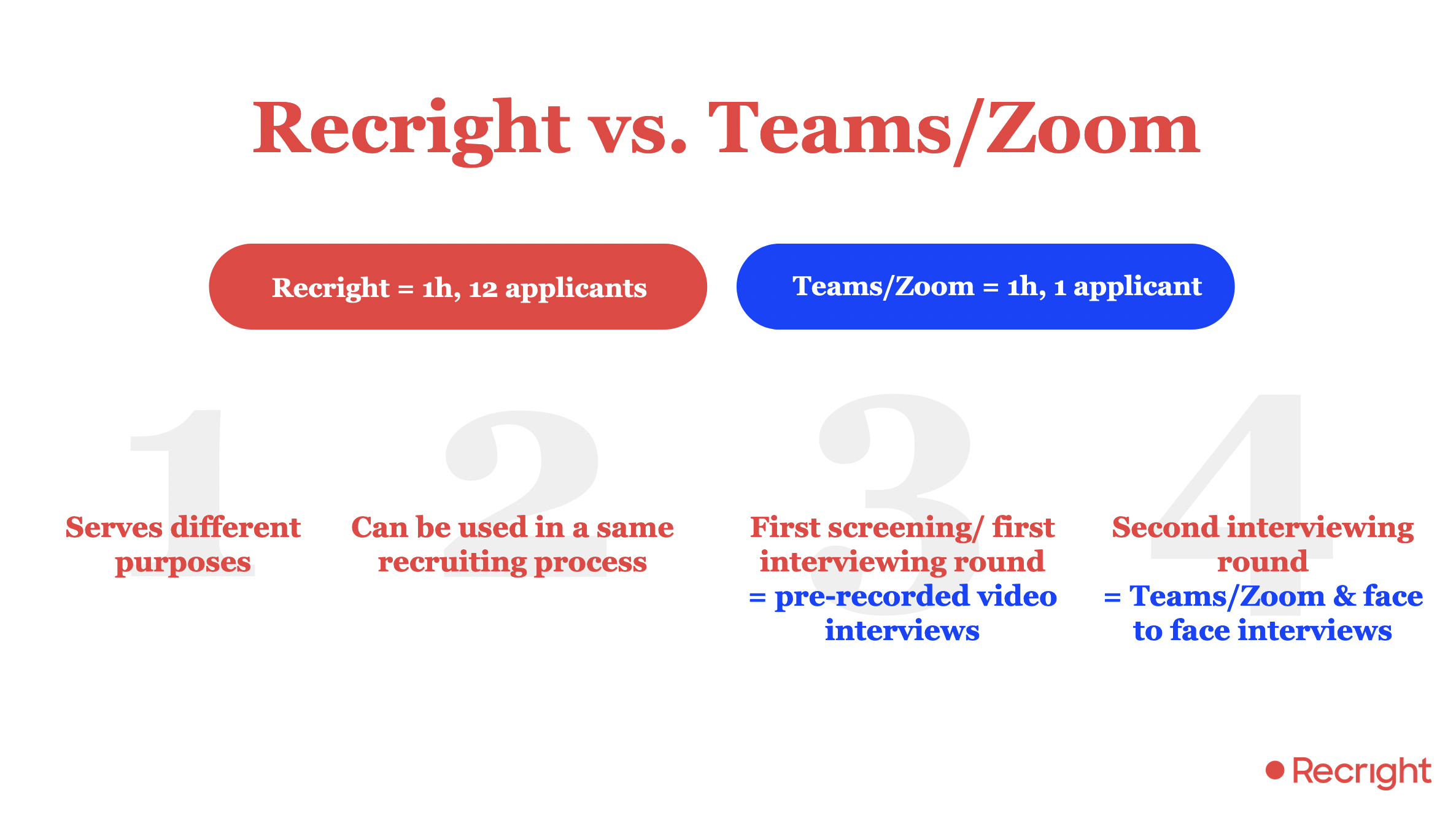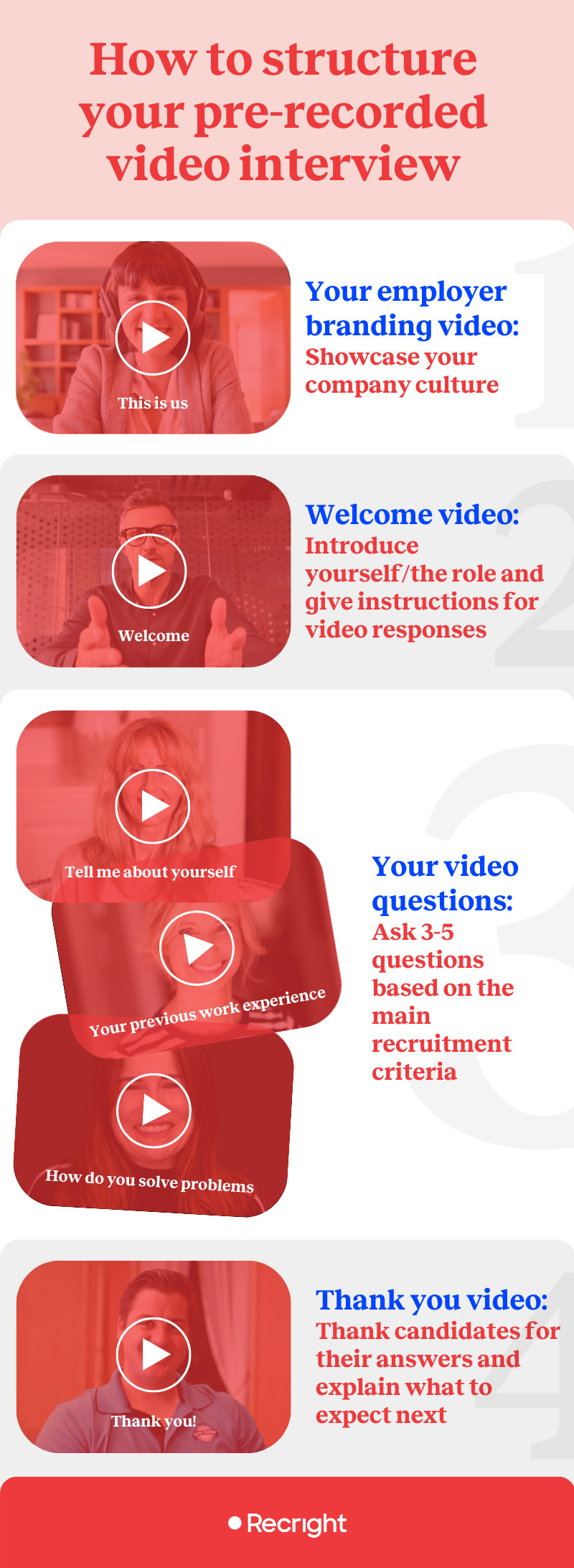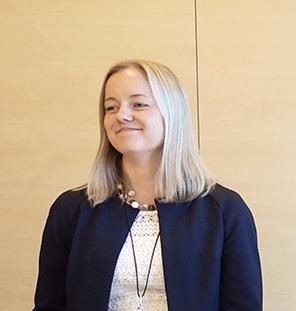Recright vs. Zoom, Google Meet, and Teams: What’s the difference?

When you hear the term “video interview,” what is the first thing to come to your mind? Probably, live interviews with candidates via Microsoft Teams, Zoom, Google Meet, or whichever video conferencing tool you use.
Many people use the term “video interview” to refer to both live and pre-recorded video interviews, so the differences between these can be confusing. But pre-recorded video interviews—one of Recright’s products—have their own place in the hiring process and bring specific benefits.
To dispel the confusion around video interviews, we’re clarifying the purpose of both video interview types, and sharing tips for when to use them in the recruitment process.
Recright serves a different purpose than Teams, Zoom, and Meet
To be clear, Recright is not a competitor of Teams, Zoom, Meet, Skype, or any other video conferencing tool—both pre-recorded and live video interviews have their own role in a hiring process.
Let’s get into when it makes most sense to use each video interview type.
Pre-recorded video interviews work best for the first screening or interview round
You can use pre-recorded video interviews (also referred to as one-way interviews or asynchronous interviews) at different stages in your hiring process, but they’re best suited for screening candidates faster so that you can spend most of your time with good-fit candidates.
Pre-recorded videos aren’t meant to replace all your face-to-face interviews. Instead, they help you avoid meeting unfit candidates in person and save time during the early hiring phase.
How exactly do they work? First, you record video questions and invite candidates to share video responses. Both you and the candidates can record the videos asynchronously (whenever and wherever you prefer), which takes away the hassle of scheduling and gives everyone more flexibility. Other people involved in hiring can then watch the video responses on their own time, which increases transparency in the recruitment process.
By having fewer live interviews, you can save about 55% of your time during the screening process. This translates to big cost savings: if you save two hours per candidate with pre-recorded video interviews when screening 10,000 hires annually, that’s about 20,000 hours and €2M saved a year.

For an instant estimate of your potential savings from using pre-recorded interviews, use our ROI calculator here.
Live video interviews work best for the second interview round
Live—or synchronous—video interviews are best suited for the second interview round with the most promising candidates. When the hiring decision comes down to three or four candidates, for example, you’ll want to book live interviews—whether in-person or through video.
Live video interviews are a real-time conversation. They give you and candidates the chance to ask follow-up questions and get to know each other better.
Here’s how Reaktor’s HR Specialist, Ossi Kontio approaches live interviews: ”We try to make our face-to-face interviews more of a ”Let’s have a cup of coffee and hang out for a bit” type of situations rather than ”I’m asking questions and you’re answering nervously” interviews. We want to get to know—and get a better feel of each other. After all, both parties need to like each other on some level if we want to work together at Reaktor.”

Tips for using pre-recorded video interviews
Now that you know the purpose of pre-recorded video interviews, how can you make the most of them during the early phase of a hiring process? Here are a few concrete ideas you can put into practice.
Mention video interviews in the job ad
Job seekers expect transparency during the hiring process. In the job ad and on your careers site, mention that pre-recorded video responses will be an early step in the process so that applicants will know what to expect.
Communicate your employer brand
Every interaction you have with candidates affects your employer brand and the candidate experience.
Video interviews can help you create a positive employer brand, as it’s a place where you show your face and personality—which reflects your organizational culture. Be conscious about how you present yourself in each video you record and each message you send.
What does your email invitation to the video interview look like? Do you send a thank you video along with your questions? Do you send confirmation emails after applicants successfully send their video responses? Do you keep in touch with candidates and provide them with useful feedback on their application?
You can also create employer branding videos to share with applicants, such as:
- Company culture videos: Explain honestly who you are as a company and why your candidate should want to work for you. Share your company values, goals, and vision for the future. The ideal length of a company culture video is two to three minutes.
- Event videos: Show the more informal side of your culture by assembling clips from company events, team days, or afterworks into a video.
- Employee videos: Show off your wonderful employees through video introductions. Have employees from different departments share how they contribute to the company mission, or have someone interview different employees around the office.
Introduce your company and the role
Give candidates a better sense of the company and the role through a welcome video. In the welcome video, you can introduce yourself and the team, promote the company culture, tell candidates what’s coming up in the video questions, provide instructions, and more.
Use the welcome video as an opportunity to start onboarding your candidates to the job, give them a feel for what their work would be like, and let them know about any requirements. Does the position require employees to obtain a police clearance certificate? Do you offer free relocation to help your hires move from abroad? Do you work in the food and beverage industry and require employees to get a hygiene passport? Whatever it might be, tell candidates what they need to know about the role.
For example, our client Viking Line takes their video interview process to the next level by explaining to candidates what it’s like to work on a cruise ship.
Here’s how you can structure your pre-recorded video interview:
You can save your videos in this order.

Pay attention to the details
Prepare for the video interview by checking some basic things: Make sure you’re in a well-lit, quiet room so that candidates could see and hear you well. There shouldn’t be any bright light behind you.
If you’re recording indoors during the daytime, make sure the window is in front you. And if you’re recording when it’s dark out, turn on a lamp that’s just above your head for better lighting. Also check that the camera is at the height of your eyes.
Remember that you set the tone for candidates’ video responses. Stay relaxed and be natural in your videos to help your candidate feel more at ease recording their responses. Mind your body language: remember to smile and look at the camera.
After recording your video, you can play it to check that your voice is audible, and if necessary re-record it to speak more clearly or move to a space with better acoustics.
Give clear and simple instructions
When it comes to video interviews, less is more. Ask three to five questions in total, and ask just one question per video. This will make it easier for candidates to answer, and easier for you to go through the responses. Remember to name your video questions with a clear and simple title.
Give your candidates clear guidelines for the video answers. For example, avoid saying: “Please keep your video answers short,” and instead, say: “Keep your answers under a minute and a half.”
Engage your team
It’s a good idea to have the hiring manager record the intro and thank you videos, and have some other team members asking the questions. This will get candidates familiar with their potential future colleagues, and help them feel more at home during their first days at work.
Think carefully about what questions you’ll ask
What do you need to know about the candidates to make a smart hiring choice? Create your interview questions based on the main recruitment criteria—this will help you identify the right candidates straight away. Also think about how to ask questions to get the most out of candidates’ responses.
If the job requires some independent thinking or some special skills, ask the candidate to explain their thought process about a task in their own words.
Send video messages throughout the process
Candidates love to get updates about the recruitment progress. After the candidates send their video responses, you can send additional video messages with relevant information or feedback.
You can also ask additional questions through a video message if needed, or kindly let candidates know you’ve decided not to move forward with their application.
Test candidates’ language proficiency
If you want to get an accurate sense of candidates’ language skills, pre-recorded video interviews can be a great way to do so. Finnair, for example, uses timed pre-recorded interviews to test language proficiency, where candidates have a limited number of retakes.

“English is increasingly becoming the main working language at Finnair and with Recright, we can gain a better understanding of a candidate’s language skills.”
— Sanna De Luca from Finnair’s Talent Acquisition team.
Tips for using live video interviews
Follow these tips to make the most of live video interviews with your best-fit candidates—no matter what video tool you’re using.
Use a scheduling tool
To avoid the back-and-forth emails to schedule live interviews, you’ll want to use a scheduling tool like Calendly. These tools make it much easier to lock in a date and time with your candides.
It’s even better if your recruitment platform has a built-in scheduling tool. For example, Recright has a scheduling feature that allows recruiters to manage all aspects of the recruitment process in one place.
Record the interview (with the candidate’s permission)
A major benefit of pre-recorded interviews is that you and anyone else involved in the hiring decision can watch (and re-watch) the video replies, and leave comments and ratings in the same place.
If someone can’t make the live video interview but you want their opinion on the candidate, you can ask the candidate’s permission to record the interview. Make sure to explain why you’re recording the interview and that it will only be used for internal purposes.
Make sure that you can record the interview in your video conferencing tool ahead of time, and check if it’s possible to do so in your recruitment platform. In Recright, you can conduct and record live interviews in addition to pre-recorded interviews.
Standardize the interview questions
Live video interviews tend to be less structured than pre-recorded video interviews. While it’s natural to let the conversion change course, you’ll still want to go into the live interview with a set list of questions. This will create more consistency between the interviews and help you make fair hiring decisions.
Use Recright and video conferencing tools in the same recruitment process
Live and pre-recorded video interviews are not mutually exclusive—you want to use both in your recruitment process.
To sum it up, here’s what a typical hiring process using both video interview types might look like:

Curious about giving pre-recorded video interviews a try? Try Recright for free and see it for yourself.
